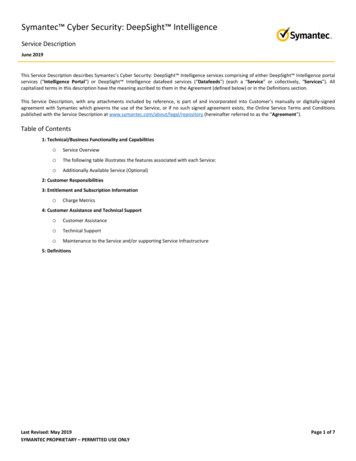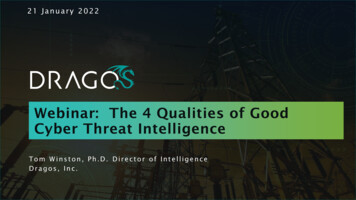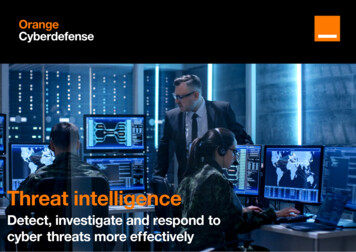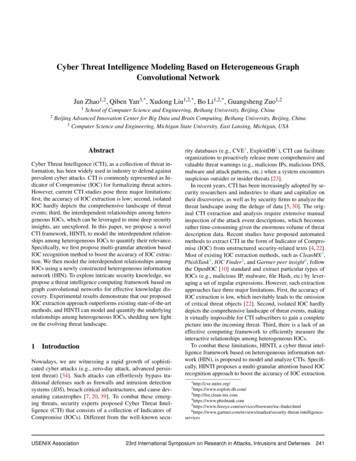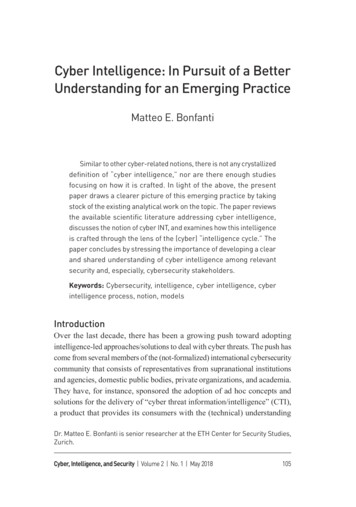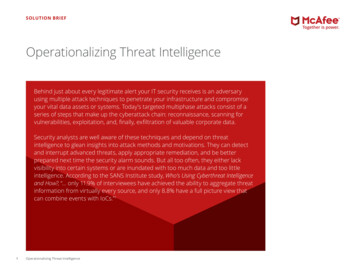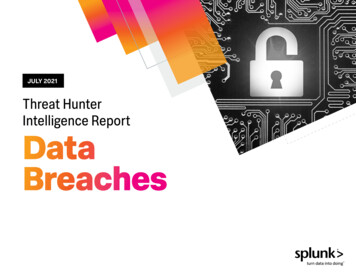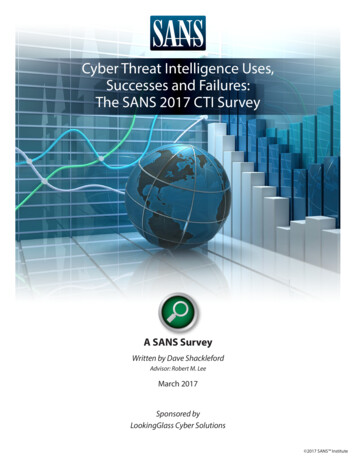
Transcription
Cyber Threat Intelligence Uses,Successes and Failures:The SANS 2017 CTI SurveyA SANS SurveyWritten by Dave ShacklefordAdvisor: Robert M. LeeMarch 2017Sponsored byLookingGlass Cyber Solutions 2017 SANS Institute
Executive SummaryOver the past year, Yahoo revealed the largest data breaches in history,1CTI Teams and Skills60%and nation-state hacking activity was suspected in tampering with the U.S.presidential election.2 More vulnerabilities are being found (and exploited) inactively use CTI, with another25% planning tomobile and Internet of Things (IoT) platforms, and the first true IoT botnet (Mirai)became a threat that was operationalized to take down Deutsche Telecom, KCOMand Irish telco Eir in December 2016. The attacks continue to spread through47%have a dedicated team thatfocuses on CTI65%—the vast majority—operatefrom the cyber security teamsdifferent types of IoT devices and target more businesses, types of routers, andother devices they can use to wreak havoc on the businesses they target.3Malware is more sophisticated in avoiding detection, and ransomware hasbecome the top threat affecting organizations,4 according to the SANS 2016Threat Landscape Survey. IT security teams are struggling just to keep up, asthey have throughout Internet history, let alone get ahead of the attackers.utilize in-house staff combined47% with service providers toeasier to detect and respond to, according to our recently conducted survey onconduct CTI44%Cyber threat intelligence (CTI) shows promise in making these types of threatsrate awareness of attackpatterns and indicators ofcompromise (IoCs) as their mostin-demand skills for leveragingCTI in detection and responsecyber threat intelligence. In this, our third survey on CTI, 60% of organizationsoverall are using CTI, while another 25% plan to. As we might expect, smallorganizations with fewer than 2,000 employees are less likely to plan to use CTI.Of those using CTI, 78% felt that it had improved their security and responsecapabilities, up from 64% in our 2016 CTI survey.CTI DefinedThe SANS CTI Forensics course defines CTI as the “collection, classification,and exploitation of knowledge about adversaries.”5 This includes, inparticular, information about adversaries’ tactics in order to detect and blockthem. As one of the course’s primary authors describes it, “CTI is analyzedinformation about the intent, opportunity and capability of cyber threats.”Exploits on removablemedia forced us toimplement controlsbanning their use in ourinfo system. WithoutCTI adopters are also facing challenges. In this survey, their biggest challenges to the effectivecredible CTI andimplementation of CTI are a lack of trained staff, lack of funding, lack of time to implementuse cases, we wouldnot have known toimplement the controlnew processes, and lack of technical capability to integrate CTI, as well as limited managementsupport. Those challenges indicate a need for more training, as well as easier, more intuitivetools and processes to support the ever-growing use of CTI in today’s networks.These and other trends and best practices are covered in this report.in our organization.—2017 CTIsurvey respondentSANS ANALYST o-hack.html? r eregister.co.uk/2016/12/02/broadband mirai takedown analysis4“Exploits at the Endpoint: SANS 2016 Threat Landscape igence1Cyber Threat Intelligence Uses, Successes and Failures: The SANS 2017 CTI Survey
Who’s Using CTIOf the 600 respondents to take this survey, 60% utilize CTI for detection and response,while another 25% plan to the future. The remaining 15% have no plans to adopt CTIpractices.Who Took This SurveyRespondents represented a broad range of industries. The top verticals includedgovernment, banking and finance, technology, and cyber security, with a mix of othersthat include education, healthcare, manufacturing and telecommunications. Thirtyeight percent of respondents worked in organizations with 2,000–50,000 employees,and 19% were in organizations larger than 50,000. Forty-three percent of organizationsrepresented have 2,000 employees or fewer. See Figure 1.What is the size of the workforce at your organization,including employees, contractors and consultants?20%15%10%5%More than ,000Fewer than 1000%Figure 1. Workforce SizeThe majority of organizations have operations in the United States (over 75%), with 40%operating in Europe and 34% in Asia. A mix of organizations has operations in Canada,Australia/New Zealand, the Middle East, South America and Africa, too. The U.S. housedthe headquarters of 67%, with 13% based in Europe and 7% headquartered in Asia.The roles of respondents also varied widely. Security administrators or analysts made up25% of the sample (far fewer than last year), with another 13% in security managementand executive roles (CSO and CISO). Over 16% were in IT operations or IT management,and many other roles were listed, including security architects, security researchers,CTI analysts and more. This year, 6% of respondents carry the title of “cyber threatintelligence analyst” or a similar title, compared to 1% who held such a role in 2016.66SANS ANALYST PROGRAM”The SANS State of Cyber Threat Intelligence Survey: CTI Important and -important-maturing-371772Cyber Threat Intelligence Uses, Successes and Failures: The SANS 2017 CTI Survey
Who’s Using CTI(CONTINUED)Using Threat IntelligenceRaw Threat IntelligenceIndicators of compromise and other potentialidentifiers of malicious behavior that can be usedto look for threats or apply preventive, detective orresponsive actionsFinished Intelligence ReportThreat intelligence data that has been analyzedin context with other information and appliedspecifically to the organization and its use casesAs security teams become more comfortable with leveraging CTI, many areconstantly seeking new and varied sources of threat data. This year’s surveyreveals a significant shift toward developing internal threat intelligence,as well. Currently, 8% of teams are producing raw threat intelligence, withanother 7% producing finished reports on their own.The majority are still consuming data from elsewhere, though, with roughly40% consuming raw data and 47% consuming finished intelligence reportsfrom vendors and other sources. Many are also producing and consumingboth, as shown in Figure 2.Indicate whether your organization produces or consumes cyber threat intelligence (CTI)in terms of raw data and/or finished threat intelligence reports.ProduceConsumeBoth100%80%60%40%20%0%Raw threat dataFinished threatintelligence reportsFigure 2. CTI Production/ConsumptionRaw CTI data creation and consumption are critical for organizations to cultivate, asthese data are the most usable in correlation and analysis. This can be incredibly timeconsuming, however. Consuming “finished” threat intelligence reports from outsidesources is most definitely the easiest way to obtain this threat data and potentially putit to use.SANS ANALYST PROGRAM3Cyber Threat Intelligence Uses, Successes and Failures: The SANS 2017 CTI Survey
Who’s Using CTI(CONTINUED)CTI Data SourcesOn that note, we saw organizations leveraging a wide variety of external CTI sources in2017. The top source by a significant margin included industry and community groupssuch as computer emergency readiness teams (CERTs) and information sharing andanalysis centers (ISACs; 73%). This was largely the same as 2016 (74%). The second mostutilized source of CTI changed radically from 2016, however. In 2017, 54% gatheredCTI from a variety of internal sources, including security and operations tools. In 2016,internal sources were fourth (46%), with the second and third most popular sourcesbeing security vendor feeds and open source/public feeds. Vendor feeds and opensource/public feeds came in third (52%) and fourth (50%), respectively, in 2017. See thefull 2017 results in Figure 3.Where is your CTI information derived from?Select those that most apply.60%40%20%OtherOther formal and informalgroups with a shared interestIntelligence feeds from CTIvendors (specifically)Open source or public CTI feeds(DNS, MalwareDomainList.com)Intelligence feeds from securityvendors (general)Internal sources(using our existing securitytools and feeds)Community or industry groupssuch as ISACs and CERT0%Figure 3. CTI SourcesLooking at the data in Figure 3, this seems to suggest that more and more organizationsare choosing a hybrid model of CTI data collection, with a mix of external and internalsources.SANS ANALYST PROGRAM4Cyber Threat Intelligence Uses, Successes and Failures: The SANS 2017 CTI Survey
Who’s Using CTI(CONTINUED)Managing CTI DataOf those who knew how many threat indicators their systems could successfullyintegrate into their workloads, 19% (the largest group) said they can handle roughly11–100 indicators coming in, while 22% can effectively utilize 1–10 per week. The fullbreakdown of responses is shown in Table 1.Table 1. Volume of CTI DataTAKEAWAYAs more vendors and sources ofdata enter the CTI ecosystem,the need to scale and, moreimportantly, to refine data tomake it relevant, will becomemore critical for CTI collectionand analytics.Number of 0%0.4%1,000,001–10,000,0002.1%1.3%Greater than 10,000,0001.7%0.0%These results differ from our 2016 survey, in which larger percentages of respondentssaid their organizations effectively utilize between 1 and 100 indicators on a weeklybasis. In 2017, respondents report that their organizations can effectively utilize morethan 100 indicators effectively.However, these numbers are estimates on the part of respondents. The vast majoritystated that they just didn’t know how many indicators they received or could use. And,given the relative immaturity of CTI, this may be the case for some time to come. Ofcourse, this could also signal a gap in what vendors and customers understand aboutthreat intelligence, with vendors providing information about how organizations canconsume intelligence efficiently that customers may not yet understand.SANS ANALYST PROGRAM5Cyber Threat Intelligence Uses, Successes and Failures: The SANS 2017 CTI Survey
Who’s Using CTI(CONTINUED)Threat Intel TeamsWhether producing or consuming CTI, almost 47% of respondents indicated that theyhave a formal team dedicated to CTI currently, which is up significantly from 2016 (28%).Another 9% have a single team member dedicated to CTI (a decrease from the 18% in2016), which indicates that the size of CTI teams is growing. Another 26% of respondentsstated they don’t currently have a person or team dedicated to CTI, but treat it as ashared responsibility between security groups (see Figure 4).Does your organization have resources that focus on CTI?Yes, a format dedicated teamYes, a single dedicated personYes, it’s shared responsibility with staffpulled from other security groupsNo responsibilities assigned, but we plan toNo responsibilities assigned, with noplans toUnknownFigure 4. Staff and Team Allocation for CTIIn-house and in-house/outsourced CTI is almost evenly split: Most organizations employan in-house team (48%), with another 47% outsourcing some aspects of this function.Only 6% outsource CTI entirely.7 Sources of outsourced information can provide differentintel, and perhaps different expertise and experience, but the trend is clearly movingtoward more in-house CTI collection and management.7SANS ANALYST PROGRAMThe total is more than 100% due to rounding error.6Cyber Threat Intelligence Uses, Successes and Failures: The SANS 2017 CTI Survey
Who’s Using CTI(CONTINUED)Those organizations that do have dedicated staff for CTI predominantly situate themin the cyber security and incident response (IR) groups, similar to 2016, where mostorganizations had CTI-focused staff in the security operations center (SOC) and IRteams. Other 2017 respondents have CTI-focused staff in the enterprise security team,with a smaller number assigning these functions to IT teams, dedicated CTI teams orvulnerability management teams (see Figure 5).Where do CTI team members reside (or where are team members drawn from)within the organization? Select those that most apply.60%40%20%OtherBusiness groupStandalone teamdedicated to CTIVulnerability managementteamIT teamEnterprise security teamSecurity operations centerIncident response teamCyber security team0%Figure 5. CTI Team and Staff LocationNote that respondents could select multiple responses, indicating that there is anoverlap where the team members fill multiple roles and, thus reside in multiplelocations, in both security and IR teams, for example. In fact, 41% chose just one locationfor team members, while the remaining 59% chose between two and eight locations,with three locations accounting for 14% of respondents.Responses indicate the need for highly specialized skills that are hard to come by. Theoverall most valuable skills listed were awareness of attack patterns and indicators ofcompromise (IOCs), intelligence analysis, incident response, and knowledge of normaland abnormal behaviors.SANS ANALYST PROGRAM7Cyber Threat Intelligence Uses, Successes and Failures: The SANS 2017 CTI Survey
Who’s Using CTI(CONTINUED)This year, correlation and analysis ranked fifth in overall value, preceded by knowledgeof normal and abnormal behavior, while presentation and communication were rankedas the overall least valuable for using CTI (see Figure 6).In 2016, correlation rulecreation and knowledge ofadversaries and campaignswere considered the mostvaluable skills for utilizing CTI.In this year’s survey, awarenessof attack patterns andknowledge of IoCs, intelligenceanalysis and incident responseare the overall top skills neededto utilize CTI.What skill sets are most valuable in leveraging CTI in detection and response?Please identify your top 3, with “1” being the most valuable.1 (Most valuable)23Awareness of attack patterns and indicators ofcompromise (IOCs)Intelligence analysisIncident responseKnowledge of normal and abnormal behaviorsAbility to write correlation rules to link security eventsData interpretationKnowledge of critical (internal) business processesKnowledge of adversaries, campaigns and IOCsMalware analysisInstincts or ability to follow hunches and connect the dotsReporting and writingFamiliarity with new commercial and/oropen source intelligence tools and feedsPresentation and oral communicationsTAKEAWAYTeam members with skills inintelligence analysis, incidentresponse, and knowledge ofnormal and abnormal behaviorand analysis will be in highdemand for CTI work.Other0%10%20%30%40%Figure 6. Valuable Skills for Leveraging CTIFor organizations looking to improve their CTI skills, experience in detecting andresponding to attacks is important; thus, dedicated CTI analysts could likely comefrom the SOC or IR teams. The ability to communicate threats and security posture,CTI reporting and data interpretation will need to improve, including the ability tounderstand and map vulnerabilities to the threat indicators, new intelligence sourcesand more.SANS ANALYST PROGRAM8Cyber Threat Intelligence Uses, Successes and Failures: The SANS 2017 CTI Survey
CTI Uses and BenefitsJust as the largest group of respondents is housing its CTI teams in its cyber securitydepartments, the majority of respondents (72%) are utilizing CTI information in securityoperations (locating sources and/or blocking malicious activities or threats). Thesame percentage of respondents (72%) is also using CTI for incident response. The fullbreakdown of responses is shown in Figure 7.How is CTI data and information being utilized in your organization?Select all that apply.Security operations(locating sources and/or blocking malicious activities or threats)Incident responseTAKEAWAY:Given that we needintelligence and data analysisskills, as well as correlationSecurity awareness(trending data and reports to team and management)Threat management (identified threats)Vulnerability managementThreat hunting(proactively hunting for indicators of compromise)Complianceand response skills, it’snot surprising that manyorganizations are seeking toimplement CTI in securityoperations (perhaps in theSOC) and IT teams.Security prioritizationIT operations(troubleshooting infrastructure)Vulnerability prioritizationExecutive education and awareness(board of directors, C suite)Threat modeling(reverse engineering for indicators)Budget and spending prioritization and decisionsOther0%20%40%60%80%Figure 7. Top Use Cases for CTI Feed DataReutilizing the information for security awareness activities, threat management,vulnerability management and threat hunting were also very popular uses.In the case of security awareness, results indicate that CTI is making inroads into enduser and business-oriented security training and processes—in other words, asking:Who is attacking us, how are they attacking us, and how can we be ready?SANS ANALYST PROGRAM9Cyber Threat Intelligence Uses, Successes and Failures: The SANS 2017 CTI Survey
CTI Uses and BenefitsWhen our SOC encountersmalware threats, [itsemployees] send outannouncements to thestaff and give theminformation on how tohandle suspicious events.—2017 CTI surveyrespondentCTI is used to generatescenarios and indicatorsof compromise, whichare then used to informthe development of ourdetection capabilities.The CTI and stats aroundnumbers of detectedincidents are passed to therisk team, who can then usethis information to ensurethat cyber security controlsare taken seriously andcorrectly prioritised.—2017 CTI surveyrespondentFor a recent example [ofhow CTI can be used]: ourimmediate awarenessof [the] Mirai botnetattack against critical DNSinfrastructure.—2017 CTI surveyrespondentSANS ANALYST PROGRAM(CONTINUED)Real-Life Examples of CTI UsageWhen we asked organizations to give specific examples of CTI use in the environment,more than 100 respondents wrote thoughtful answers that fell into these categories: Proactively stopping malware, ransomware and advanced threats Improving detection capabilities Threat modeling Prioritizing security and response Detecting phishing emails, desktop-related targeting and end user applicationcompromise Reusing data for security staff awarenessImprovements with CTIThe majority of respondents (78%) felt that CTI had improved their security (protectionand detection) and response capabilities, which is a significant increase from 2016,where 64% saw such improvements. In 2016, only 3% indicated that CTI hadn’t improveddetection and response, and that number went down to 2% in 2017. The remainingrespondents weren’t sure.This, along with previous surveys, reveals an increase in usefulness and effectiveness ofCTI for security operations and IR over the past two years. So this year, we also lookedinto how CTI usage has improved an organization’s ability to prevent, detect andrespond to threats. See Table 2 for results.Table 2. Improvement Ratesin Prevention/Detection and ResponseSecurity(Preventionand Detection)Response29.0%31.0%No fortunately, 29% of respondents do not know by what percentage prevention anddetection capabilities had been improved as a result of using CTI. This may speak tothe need for organizations to measure their performance by a standard set of metrics.It is noteworthy, however, that not a single respondent stated that there was noimprovement in prevention/detection capabilities.10Cyber Threat Intelligence Uses, Successes and Failures: The SANS 2017 CTI Survey
CTI Uses and Benefits(CONTINUED)Measures of ImprovementThe perceptionthat breaches wereactually preventedand that “unknown”threats were detectedis a very positivechange fromprevious years.Of those who can quantify improvements in detection and prevention, 19% (the largestgroup) are experiencing 51–75% improvement, whereas only 11% experienced this levelof improvement in incident response. With respect to improvements in response, tworanges tied for the highest percentage of improvement at 18%: 11–25% and 26–50%.When it comes to response, fewer organizations can actually measure their level ofimprovements than in last year’s survey. In 2016, 19% of security teams responded thatthey did not know how much their response had improved with CTI; in 2017, 31% don’tknow. In 2016, 3% stated that they saw no discernible improvement in response fromusing CTI, and that number is down to 1% this year, but the rest of the improvementcategories are very spread out.Effectiveness of CTIFor those who felt that their security and response capabilities had improved, themajority (72%) felt that they have better visibility into threats and attack methodologies,a slight increase over 2016. In our 2017 survey, additional progress was noted inimproving security operations and detecting unknown threats (both with 63%), as wellas preventing breaches and improving incident detection and response times (both justover 50%). See Figure 8.How has the use of CTI improved your security and response?Select all that apply.Improving visibility into threats and attack methodologiesimpacting our environmentBoth SOC teamsand response andforensics teams willimmediately benefitfrom greater visibilityinto attack methodsand threats, as well asimproved detectionand response times.Improving security operationsDetecting unknown threatsPreventing breachesReducing time to identify and respond to incidentsImproving accuracy (reduced false positives)Revealing vulnerabilities where new security measuresshould be implementedReducing exposure of sensitive dataPreventing damage to business systems or dataLocating the source of events impacting our enterpriseMeasurably reducing impact of incidentsPreventing business outageOther0%20%40%60%80%Figure 8. CTI Security and Response ImprovementsSANS ANALYST PROGRAM11Cyber Threat Intelligence Uses, Successes and Failures: The SANS 2017 CTI Survey
CTI Uses and Benefits(CONTINUED)As in years past, quantitative improvements, such as measurably reducing the impact ofincidents, saw fewer respondents feeling confident that CTI had provided benefits. Thismay still reflect a lack of maturity in CTI implementation and program integration, butthe perception that breaches had actually been prevented and “unknown” threats hadbeen detected is a very positive change from years past, and could indicate that we’reslowly seeing CTI use become better understood.CTI Data AggregationSecurity teams are using a broad variety of tools to aggregate, analyze and present CTI intheir environments. In 2016, 43% were using security information and event management(SIEM) systems in an integrated GUI, and another 26% used SIEM disparately with othertools and components. In 2017, SIEM is still the top tool for managing and using CTI, withslightly higher numbers (46% with a GUI and 27%, disparately). See Figure 9.What type of management tools are you using to aggregate,analyze and/or present CTI information?Select all that apply, and indicate whether these are used disparately or work together under a unified GUI.Integrated GUIUsed DisparatelySIEM platformNetwork traffic analysis toolsIntrusion monitoring platformSpreadsheets and/or emailCommercial cyber threat intelligence management platformHomegrown management systemCTI service providerForensics platformOpen source cyber threat intelligence managementplatform (CRITS, MISP)Security analytics platform other than SIEMThird-party visualization and reporting platformOther0%20%40%60%Figure 9. CTI Integration and Analysis ToolsLast year, intrusion monitoring platforms were a close second, also predominantly withina central GUI. In 2017, however, intrusion monitoring tools were third, behind networktraffic analysis tools (mostly using a unified GUI as well). Commercial CTI managementplatforms were fifth this year, compared to third in 2016.SANS ANALYST PROGRAM12Cyber Threat Intelligence Uses, Successes and Failures: The SANS 2017 CTI Survey
CTI Uses and Benefits(CONTINUED)We were surprised to see spreadsheets taking fourth place at 61% utilization, giventhat they are not scalable or practical data management tools for most organizationswith any real volume of data. It’s as interesting to see that the commercial CTI tools,and even home-grown management, analytics platforms and third-party tools aremore commonly used under the umbrella of an integrated GUI. This suggests thatoptimization is occurring, primarily through the vendor community.Open source CTI platforms were used more often than in 2016 (in 2017, 49% used opensource, compared to 43% in 2016), but they still required more disparate integrationand coordination with other tools. Homegrown tools, analytics platforms, businessintelligence tools and forensics tools were also cited.CTI IntegrationAnywhere from 20% to 47% of respondent organizations are using disparate intelligencefeeds rather than through an integrated GUI, indicating a continued need forimprovements in integrated visualization and workflow. Most respondent organizationsare using APIs (47% are using vendor-provided APIs, and 46% are using custom APIs)to integrate security feeds into their environments. In addition to these tools, 41% usededicated threat intelligence platforms (both commercial and open source). See Figure 10.How are these intelligence feeds integrated into your defense and response systems?Select all that apply.50%40%30%20%10%OtherPrebuilt connectorsto content-orientedsystemsThird-party integratorsIntelligence serviceprovidersVia a threat intelligenceplatform (commercial oropen source)Custom APIsVendor-provided APIsand API developmentkits for security tools0%Figure 10. CTI Feed IntegrationGiven that so many organizations are using SIEM, network analysis tools and intrusionmonitoring tools for managing and using threat intelligence, it makes sense that APIdriven integration with these platforms would be prevalent.SANS ANALYST PROGRAM13Cyber Threat Intelligence Uses, Successes and Failures: The SANS 2017 CTI Survey
CTI Uses and Benefits(CONTINUED)CTI ReportingMore organizations are using CTI and procuring it from a number of sources. Many arealso relying on external providers to get CTI reports, although some are also developingtheir own internally. Roughly 51% of respondents stated that their CTI reports anddata are good, but they need some manual “cleaning” and manipulation. Only 14% feltthat the reports were excellent, integrating cleanly into their detection and responseprograms today.However, 32% acknowledged getting CTI data but not currently knowing how tomake use of it. This goes back to the issues with normalizing and filtering the datafor applicability in the target enterprise. Only 1% of respondents said CTI is currentlyentirely useless to them.32%Percentage that collectCTI data but are unsureof how useful it is intheir organizationsOrganizations are using a variety of standards and frameworks to support feedintegration, analysis and reporting. In our survey, 40% of respondents (the majority)are using Structured Threat Information Expression (STIX ). The Open Indicatorsof Compromise (OpenIOC) framework came in second this year with 38%, and theCollective Intelligence Framework (CIF) came in third at 32%. Many organizationsmarked the “other” category and listed commercial vendors, homegrown tools and more.The complete list is illustrated in Figure 11.Which of the following standards or frameworks is your CTI information adhering to?Select all that apply.40%30%20%10%Vocabulary for Event Recordingand Incident Sharing (VERIS)Incident Object Descriptionand Exchange Format (IODEF)OtherCyber Observable eXpression(CybOX )MISP (Malware InformationSharing Platform)Collective IntelligenceFramework (CIF)Open Indicators of Compromise(OpenIOC) frameworkStructured Threat InformationExpression (STIX )0%Figure 11. CTI Standards and SolutionsSANS ANALYST PROGRAM14Cyber Threat Intelligence Uses, Successes and Failures: The SANS 2017 CTI Survey
CTI Uses and Benefits(CONTINUED)In contrast, in 2016 STIX was used by 29% of organizations, CIF was second with 26%and OpenIOC was third with 17%. All in all, not a major change year to year. Lookingback over the past several years, we’ve seen some fluctuation in the types of tools andstandards employed in CTI programs. Some of the MITRE standards, for example STIX ,have remained popular. But many community initiatives and tools have also emerged,including Cyber Observable Expression (CybOX ) and others. Today, it seems that thereis no clear “winner” in these standards, although the same ones routinely surface asbeing the most prevalent overall.TAKEAWAY:Level of Satisfaction with CTI ElementsOrganizations are gettingIn general, teams are most satisfied with the relevance of threat data and informationgood, relevant data in a timely(80%), cleanliness and quality of data (76%), and timeliness of CTI and visibility intofashion, which indicates thatthreats and IOCs (tied at 74% each). These are very critical points to note, given that mostCTI providers and communitysources are improving theirteams are leveraging CTI in their SOC and IR teams and finding the most valuable uses tobe visibility into threats and attacks, as well as more rapid detection and response.Tabl
become the top threat a"ecting organizations, 4 according to the SANS 2016 Threat Landscape Survey. IT security teams are struggling just to keep up, as they have throughout Internet history, let alone get ahead of the attackers. Cyber threat intelligence (CTI) shows promise in making these types of threats


